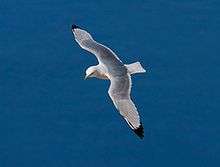Black-legged kittiwake
| Black-legged kittiwake | |
|---|---|
.jpg) | |
| Calls, recorded on Skomer | |
| Scientific classification | |
| Kingdom: | Animalia |
| Phylum: | Chordata |
| Class: | Aves |
| Order: | Charadriiformes |
| Family: | Laridae |
| Genus: | Rissa |
| Species: | R. tridactyla |
| Binomial name | |
| Rissa tridactyla (Linnaeus, 1758) | |
| | |
| Range of R. tridactyla Summer range Wintering range | |
The black-legged kittiwake (Rissa tridactyla) is a seabird species in the gull family Laridae.
This species was first described by Linnaeus in his Systema naturae in 1758 as Larus tridactylus.[2] The English name is derived from its call, a shrill 'kittee-wa-aaake, kitte-wa-aaake'.[3] The genus name Rissa is from the Icelandic name Rita for this bird, and the specific tridactyla is from Ancient Greek tridaktulos, "three-toed", from tri-, "three-" and daktulos, "toe".[4]
In North America, this species is known as the black-legged kittiwake to differentiate it from the red-legged kittiwake, but in Europe, where it is the only member of the genus, it is often known just as kittiwake.
Description
The adult is 37–41 cm (15–16 in) in length with a wingspan of 91–105 cm (36–41 in) and a body mass of 305–525 g (10.8–18.5 oz).[5] It has a white head and body, grey back, grey wings tipped solid black, black legs and a yellow bill. Occasional individuals have pinky-grey to reddish legs, inviting confusion with red-legged kittiwake. In winter, this species acquires a dark grey smudge behind the eye and a grey hind-neck collar.
| Standard measurements[6][7] | |
|---|---|
| length | 410–460 mm (16–18 in) |
| weight | 400 g (14 oz) |
| wingspan | 910 mm (36 in) |
| wing | 295–322 mm (11.6–12.7 in) |
| tail | 124–136 mm (4.9–5.4 in) |
| culmen | 33–39 mm (1.3–1.5 in) |
| tarsus | 32–36 mm (1.3–1.4 in) |
Breeding
It is a coastal breeding bird around the north Pacific and north Atlantic oceans, found most commonly in North America and Europe. It breeds in large colonies on cliffs and is very noisy on the breeding ground. Cliff nesting for gulls occurs only in the Rissa species, and the kittiwake is capable of utilizing the very sheerest of vertical cliffs, as is evident in their nesting sites on Staple Island in the outer Farne Islands. One to two buff spotted eggs are laid in the nest lined with moss or seaweed. The downy young of kittiwakes are white, since they have no need of camouflage from predators, and do not wander from the nest like Larus gulls for obvious safety reasons.
At fledging, the juveniles differ from the adults in having a black 'W' band across the length of the wings and whiter secondary and primary feathers behind the black 'W', a black hind-neck collar and a black terminal band on the tail. The old fisherman's name of "tarrock" for juvenile kittiwakes is still occasionally used.
Feeding
They are fish feeders, and are more pelagic than Larus gulls outside the breeding season. They do not scavenge at landfill some other gull species.
Subspecies
There are two races of black-legged kittiwake:
- R. t. tridactyla – (Linnaeus, 1758): nominate, found in the North Atlantic Ocean, is unique among the Laridae in having only a very small or even no hind toe.
- R. t. pollicaris – (Ridgway, 1884): found in the north Pacific Ocean, has a normally developed hind toe (as the name pollex, meaning thumb, suggests).
Gallery
-

In flight, Heligoland, Germany
-

In Seward, Alaska
-

-

Colony at Svalbard
-

Chased by a parasitic jaeger at Svalbard
-

At the Norwegian bird-island Runde
-

At Runde
-

On nest with chick
-

Adult and chicks
-

Youth (Iceland)
-

ID composite
-

Capture of individuals for tagging
References
- ↑ BirdLife International (2012). "Rissa tridactyla". IUCN Red List of Threatened Species. IUCN. 2012: e.T22694497A38874175. Retrieved 30 April 2016.
- ↑ Linnaeus, C. (1758). Systema naturae per regna tria naturae, secundum classes, ordines, genera, species, cum characteribus, differentiis, synonymis, locis. Tomus I. Editio decima, reformata (in Latin). Holmiae [Stockholm]: (Laurentii Salvii). p. 136.
L, albicans dorso canescente, rectricibus excepto extimo nigris, pedibus tridaclylis.
- ↑ "Kittiwake". Oxford English Dictionary (3rd ed.). Oxford University Press. September 2005. (Subscription or UK public library membership required.)
- ↑ Jobling, James A (2010). The Helm Dictionary of Scientific Bird Names. London: Christopher Helm. pp. 336, 390. ISBN 978-1-4081-2501-4.
- ↑ "Black-legged kittiwake". All About Birds. Cornell Lab of Ornithology.
- ↑ Godfrey, W. Earl (1966). The Birds of Canada. Ottawa: National Museum of Canada. p. 186.
- ↑ Sibley, David Allen (2000). The Sibley Guide to Birds. New York: Knopf. p. 229. ISBN 0-679-45122-6.
External links
| Wikimedia Commons has media related to Rissa tridactyla. |
| Wikispecies has information related to: Rissa tridactyla |
- BirdLife species factsheet for Rissa tridactyla
- "Rissa tridactyla". Avibase.

- "Black-legged kittiwake media". Internet Bird Collection.
- Black-legged kittiwake photo gallery at VIREO (Drexel University)
- Interactive range map of Rissa tridactyla at IUCN Red List maps
- Black-legged kittiwake - Rissa tridactyla - USGS Patuxent Bird Identification InfoCenter
- Audio recordings of Black-legged kittiwake on Xeno-canto.
- Rissa tridactyla in the Flickr: Field Guide Birds of the World
- Black-legged kittiwake media at ARKive

